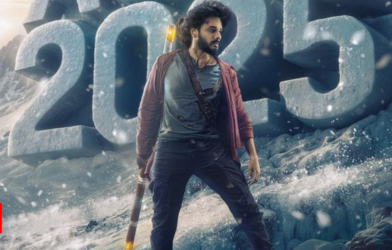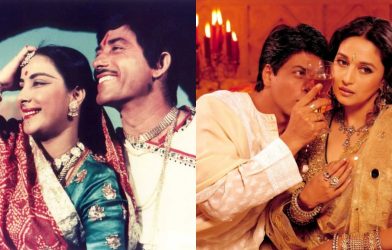Indian cinema is over 100 years old and there has been a general consensus that over the many decades, the 1980s were categorically the worst time for Hindi movies. This was the decade when films like Tohfa, Nagina, Insaf Ki Pukar, Mard were actual hits at the box office and the audience was starting to feel like perhaps the best of movie days were behind them. Frustrated with what was being offered, the audience started looking elsewhere for options, and luckily for them, the new technology of VHS was just taking off. There was a lack of good movies in theatres, and the cheap alternative of home videos started a loop where the audience needed an event, something extraordinary to actually go to the cinemas. Moviemakers had to be jolted out of their inertia to start making good cinema once again. In many ways, the 2020s are starting to feel like a repeat of the 1980s and the recent success of Sanam Teri Kasam is a huge indicator that the worst times are upon us.
Two weeks ago, among the many re-releases in cinemas, Harshvardhan Rane and Mawra Hocane-starrer Sanam Teri Kasam re-released in theatres after its original release in 2016. Back in the day, Sanam Teri Kasam received mediocre reviews and was a flop at the box office but now, almost nine years later, people have suddenly woken up to this so-called ‘gem’. The film is available on ZEE5 but despite that, there are people paying money, and watching it at a theatre. But why? Sanam Teri Kasam, as a film, feels like it is straight out of the 1980s and reminds you of films like Bewafa Sanam or Souten Ki Beti from those disappointing Zee Cinema afternoons.
Sanam Teri Kasam starts off with an Ugly Betty-like premise where the protagonist’s only problems are her glasses and unkempt hair. There’s an unforgiving Manish Chaudhary performance here that even he wouldn’t revisit, and a terrible storyline which makes you wonder if this is one of those ‘so bad it’s good’ movies. At one point, they recycle Harivanshirai Bachchan’s poetry but in their own words, and fully pretend like they came up with it. And as you watch more and more of this, you realise that if this is a hit in 2025, the crisis of cinema is well on its way.
Like the VHS of those days, we now have streaming platforms that give us oodles of options in the comfort of our homes. The pandemic gave a boost to the streaming industry and even if they continue to make the likes of Dhoom Dhaam, or Wild Wild Punjab, it’s still better than going out and spending money because here, you at least have the option of getting out whenever you want. And since the audience is already spending a significant amount of money on these streaming platforms, and unlike those VHS tapes, these are fully legal, movie makers need to do something extravagant if they want audience to come to the cinemas.
Many filmmakers have spoken about how the economics of movie-making for theatres actually depends on streaming platforms as no film gets made without an OTT deal. Movie making has always been a mix of art and commerce but it is well known that one can’t function without the other. In the last few years, it has been advantage commerce as the discussion about quality of films has been drowned by box office numbers.
This decade started on a dismal note for Hindi cinema as we were just entering the pandemic. The first two years didn’t see many Hindi releases and of course, the industry was badly affected. In 2022, the conversation around Hindi films going through a bad patch gained steam but with films like Pathaan, Jawan, Gadar 2 and Animal in 2023, there was this sense that Bollywood is back because films were now doing Rs 1000 crore at the box office. But is good box office an indicator of good cinema? We all know the answer to that question. Even in 2024, when films like Stree 2 and Bhool Bhulaiyaa 3 were box office hits, there was a conscious sense that unlike hits of the previous years, which actually had some kind of pop culture impact, these films were out of the public memory in a few weeks. No matter how hard the PR machinery tries to turn something into a moment, if it isn’t organic, the audience doesn’t care.
Story continues below this ad
 Sanam Teri Kasam isn’t the first ‘surprise hit’ that we have seen in the last few years but just a few minutes with that film are enough to put you off Hindi movies for a long long time.
Sanam Teri Kasam isn’t the first ‘surprise hit’ that we have seen in the last few years but just a few minutes with that film are enough to put you off Hindi movies for a long long time.
Even the most mediocre of films are promoted as quality cinema because the PR machinery around them spends a bunch of time and money in making the audience believe that they must go against their own judgement, and give it a shot. And when they do, it is a reminder that Hindi cinema is dying a slow death and is in desperate need of a saviour. Such is the impact of social media that a good film like Jigra can get hate, and an excessively misogynistic film like Teri Baaton Mein Aisa Uljha Jiya can be celebrated as a ‘hit’.
Sanam Teri Kasam isn’t the first ‘surprise hit’ that we have seen in the last few years but just a few minutes with that film are enough to put you off Hindi movies for a long long time. It reminds you that Hindi cinema has lost its way and they need an ‘avatar’ to pull them out of their misery because if this keeps going on for longer, this decade will end up being more damaging that the 1980s.










